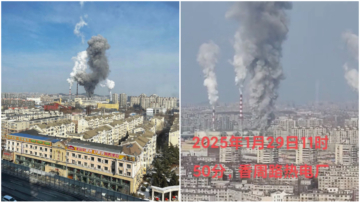【新唐人2012年12月19日訊】中國隨著人口老齡化日漸嚴重和經濟增長的減速,養老保險支出成為突出的矛盾問題。17號,中國社會科學院發表報告指出,2011年中國城鎮職工養老金收不抵支的省份達14個,收支缺口接近767億元,高於2010年。而養老金空賬額度超過了2萬億。有評論指出,中共養老金制度,體現出中共治理國家的能力問題。
根據中國社科院發佈的報告顯示,2011年中國養老金虧損省區有14個,收支缺口增加到766.5億元人民幣,遠高於2010年。其中超過一半來自東北三省,其餘來自中南部和西北省區。
《新唐人》特約經濟評論專家傑森‧馬:「整個養老金缺口這個問題,其實跟中國目前的養老金現有的結構有關,比如個人帳號、社會統籌等等這樣的因素在他社會統籌那一部分,讓企業交的部分是非常非常重的,企業的每個員工要交他的工資的20%做為養老金,這個數字在全世界是極少有的。」
中國養老金主要分為兩類:機關事業單位人員退休養老金,和企業人員退休養老金。二者實行不同的制度,外界稱為養老「雙軌制」。
養老金「雙軌制」的退休制度,企業職工方面,由企業和職工本人按一定標準繳納﹔機關和事業單位的退休金,則由國家財政統一發放,也就是直接從國家財政支出養老金。這使得企業退休職工,與機關事業單位退休人員,在養老金收入上的差距極為不合理。
據了解,企業職工養老保險繳費佔工資收入的28%,而機關和事業單位未納入社保體系,不用繳費,然而機關和事業單位退休時的養老金,卻是企業職工的3倍。
傑森‧馬:「最大的好處還是來自於中共本身集團內部的那些人,比如說一些軍隊的幹部、中共的高級幹部,就是這群人,他們實際上是把中國整個80%的醫療資源都佔用了,中共養老金的系統,實際上是中共治理國家能力的問題,中共財政撥款不夠透明的問題,中國整個分配不均的問題,不是老百姓拿得太多,工資漲的太多,這樣的問題。」
社科院的報告還顯示,2011年記賬額達到24859億,空賬額達22156億。個人帳戶空賬額繼2007年突破萬億大關後,再次突破2萬億。
據了解,早期養老保險制度的設計,依靠在職職工的繳費,來負擔已退休職工的養老金,也就是,當時在職職工的個人繳費,無法全部進入自己的個人賬戶,被部分拿去給退休者發養老金。
個人帳戶僅僅是一個虛擬帳戶,一些地方為了滿足當期的支付需要,大量動用積累的個人帳戶基金,這就造成了個人帳戶的空賬問題。
《新唐人》特約經濟評論專家傑森‧馬認為,以中國過去所謂GDP的發展速度,加上每年財政收入的百分之二、三十的增加速度,實際上早就可以補上養老金缺口。
傑森‧馬:「他完全有閒錢可以拿出一筆來補充養老金這個體系,但是他為了面子工程,比如說他願意花四千億去搞一個奧運會,花四千億去搞世貿來給中共自己添面子,但是他不願拿出錢來儲備基金,來充實他的養老金這個財政。」
中國已進入老齡化社會,截至2011年底,60歲及以上老年人口達1.85億。中國老齡工作委員會辦公室副主任朱勇表示,2013年,中國60歲以上老年人口將突破2億。
而經濟學家郎咸平的文章也披露,中國銀行等機構發佈的一項研究報告預測,到2013年,中國養老金的缺口將達到18.3萬億元。
採訪/陳漢 編輯/黃億美 後製/郭敬
Increase of Imbalance Appears in China's Pension System
As the population ages and the economic growth declines,
the pension insurance expenditures are becoming an obvious problem.
On Dec. 17, the Chinese Academy of Social Sciences
published a report pointing out that in 2011,
China's urban workers pension received less than
expenditure in 14 provinces,
a balance gap nearly 76.7 billion yuan higher than in 2010.
Pension accounts are short of more than $ 2 trillion yuan.
Some people comment that China's pension system reflects
the Chinese Communist Party's (CCP) ability to govern the country.
According to the report released by the Chinese Academy
of Social Sciences,
there were 14 provinces suffered pension losses in China in 2011.
The payments gap increased to 76.65 billion yuan,
much higher than that in 2010.
Over half of them were from the three northeastern provinces
and the rest from the south-central and northwest provinces.
New Tang Dynasty special Economic Review Expert
Jason Ma: "The entire pension gap problem, in fact,
associates with China's current pension structure,
such as personal accounts and social pooling factors.
In the social pool, the portion provided by enterprises
is very large.
Each employee of an enterprise has to pay 20% of
his salary as pension, which is rarely seen in the entire world."
The Chinese pension system is divided into two categories,
personnel at institutions retirement pension, and corporate officers' retirement pension.
Both systems have different implementation.
The outside world called the pension system, “a dual track."
Within the retirement pension "dual track" system, enterprise
employees and enterprises pay according to certain standards;
pension of organizations and institutions is provided by
the state, considered a part of the state financial expenditure.
This allows quite an unreasonable pension income gap
between the businesses' retired workers and those of the organizations and institutions.
It is understood that corporate employee pension
contribution accounts for 28 percent of their wage income.
The organizations and institutions are not included
in the social security system, not requiring payment.
However, the retirement pension of workers from
the organizations and institutions is three times as much as the enterprise workers.
Jason Ma: "The best benefit goes to the CCP inner circle.
For example, some cadres of the armed forces,
or the senior cadres of the CCP, are actually
taking up to 80% of the entire medical money.
The CCP's pension system, in fact, is the CCP's ability
to rule China.
Its problems result from lack of transparency in financial
allocations and the uneven distribution of wealth in China,
instead of from wages rising too fast or people making
too much.”
An Academy of Social Sciences report also showed
that the billing amounted to 2.4859 trillion in 2011; that is 2.2156 trillion in the red.
The personal accounts also broke the 2 trillion mark
in the red in 2007.
It is understood that the early design of the pension insurance
system relies on active employees to pay, and thus,
part of their contributions provide for the pensions of
retired workers, and the rest goes into their own accounts.
The personal account is just a virtual account, and some
places, in order to meet current payment needs of a large
number of disposable accumulated personal account funds,
turn the personal account into an empty account.
New Tang Dynasty special Economic Review expert
Jason Ma believes that with the pace of GDP development
in China, plus an annual 20-30 percent fiscal revenue,
the pension gap should have been filled.
Jason Ma: “China can come up with the money
to supplement the pension system,
but the Chinese regime favored a face-saving project,
such as spending 400 billion yuan for the Olympic Games
instead of allocating the money to the reserve fund and enriching pension finances.”
China has entered an aging society, and as of the end of 2011,
the 60-year-olds and above population reached 185 million.
Zhu Yong, deputy director of the Committee on Aging, says
the 60 years of age and older population will exceed 200 million in 2013.
Economist Lang Xianping's article also disclosed
that institutions such as the Bank of China released a research
report predicting China's pension gap will reach 18.3 trillion
yuan in 2013.
根據中國社科院發佈的報告顯示,2011年中國養老金虧損省區有14個,收支缺口增加到766.5億元人民幣,遠高於2010年。其中超過一半來自東北三省,其餘來自中南部和西北省區。
《新唐人》特約經濟評論專家傑森‧馬:「整個養老金缺口這個問題,其實跟中國目前的養老金現有的結構有關,比如個人帳號、社會統籌等等這樣的因素在他社會統籌那一部分,讓企業交的部分是非常非常重的,企業的每個員工要交他的工資的20%做為養老金,這個數字在全世界是極少有的。」
中國養老金主要分為兩類:機關事業單位人員退休養老金,和企業人員退休養老金。二者實行不同的制度,外界稱為養老「雙軌制」。
養老金「雙軌制」的退休制度,企業職工方面,由企業和職工本人按一定標準繳納﹔機關和事業單位的退休金,則由國家財政統一發放,也就是直接從國家財政支出養老金。這使得企業退休職工,與機關事業單位退休人員,在養老金收入上的差距極為不合理。
據了解,企業職工養老保險繳費佔工資收入的28%,而機關和事業單位未納入社保體系,不用繳費,然而機關和事業單位退休時的養老金,卻是企業職工的3倍。
傑森‧馬:「最大的好處還是來自於中共本身集團內部的那些人,比如說一些軍隊的幹部、中共的高級幹部,就是這群人,他們實際上是把中國整個80%的醫療資源都佔用了,中共養老金的系統,實際上是中共治理國家能力的問題,中共財政撥款不夠透明的問題,中國整個分配不均的問題,不是老百姓拿得太多,工資漲的太多,這樣的問題。」
社科院的報告還顯示,2011年記賬額達到24859億,空賬額達22156億。個人帳戶空賬額繼2007年突破萬億大關後,再次突破2萬億。
據了解,早期養老保險制度的設計,依靠在職職工的繳費,來負擔已退休職工的養老金,也就是,當時在職職工的個人繳費,無法全部進入自己的個人賬戶,被部分拿去給退休者發養老金。
個人帳戶僅僅是一個虛擬帳戶,一些地方為了滿足當期的支付需要,大量動用積累的個人帳戶基金,這就造成了個人帳戶的空賬問題。
《新唐人》特約經濟評論專家傑森‧馬認為,以中國過去所謂GDP的發展速度,加上每年財政收入的百分之二、三十的增加速度,實際上早就可以補上養老金缺口。
傑森‧馬:「他完全有閒錢可以拿出一筆來補充養老金這個體系,但是他為了面子工程,比如說他願意花四千億去搞一個奧運會,花四千億去搞世貿來給中共自己添面子,但是他不願拿出錢來儲備基金,來充實他的養老金這個財政。」
中國已進入老齡化社會,截至2011年底,60歲及以上老年人口達1.85億。中國老齡工作委員會辦公室副主任朱勇表示,2013年,中國60歲以上老年人口將突破2億。
而經濟學家郎咸平的文章也披露,中國銀行等機構發佈的一項研究報告預測,到2013年,中國養老金的缺口將達到18.3萬億元。
採訪/陳漢 編輯/黃億美 後製/郭敬
Increase of Imbalance Appears in China's Pension System
As the population ages and the economic growth declines,
the pension insurance expenditures are becoming an obvious problem.
On Dec. 17, the Chinese Academy of Social Sciences
published a report pointing out that in 2011,
China's urban workers pension received less than
expenditure in 14 provinces,
a balance gap nearly 76.7 billion yuan higher than in 2010.
Pension accounts are short of more than $ 2 trillion yuan.
Some people comment that China's pension system reflects
the Chinese Communist Party's (CCP) ability to govern the country.
According to the report released by the Chinese Academy
of Social Sciences,
there were 14 provinces suffered pension losses in China in 2011.
The payments gap increased to 76.65 billion yuan,
much higher than that in 2010.
Over half of them were from the three northeastern provinces
and the rest from the south-central and northwest provinces.
New Tang Dynasty special Economic Review Expert
Jason Ma: "The entire pension gap problem, in fact,
associates with China's current pension structure,
such as personal accounts and social pooling factors.
In the social pool, the portion provided by enterprises
is very large.
Each employee of an enterprise has to pay 20% of
his salary as pension, which is rarely seen in the entire world."
The Chinese pension system is divided into two categories,
personnel at institutions retirement pension, and corporate officers' retirement pension.
Both systems have different implementation.
The outside world called the pension system, “a dual track."
Within the retirement pension "dual track" system, enterprise
employees and enterprises pay according to certain standards;
pension of organizations and institutions is provided by
the state, considered a part of the state financial expenditure.
This allows quite an unreasonable pension income gap
between the businesses' retired workers and those of the organizations and institutions.
It is understood that corporate employee pension
contribution accounts for 28 percent of their wage income.
The organizations and institutions are not included
in the social security system, not requiring payment.
However, the retirement pension of workers from
the organizations and institutions is three times as much as the enterprise workers.
Jason Ma: "The best benefit goes to the CCP inner circle.
For example, some cadres of the armed forces,
or the senior cadres of the CCP, are actually
taking up to 80% of the entire medical money.
The CCP's pension system, in fact, is the CCP's ability
to rule China.
Its problems result from lack of transparency in financial
allocations and the uneven distribution of wealth in China,
instead of from wages rising too fast or people making
too much.”
An Academy of Social Sciences report also showed
that the billing amounted to 2.4859 trillion in 2011; that is 2.2156 trillion in the red.
The personal accounts also broke the 2 trillion mark
in the red in 2007.
It is understood that the early design of the pension insurance
system relies on active employees to pay, and thus,
part of their contributions provide for the pensions of
retired workers, and the rest goes into their own accounts.
The personal account is just a virtual account, and some
places, in order to meet current payment needs of a large
number of disposable accumulated personal account funds,
turn the personal account into an empty account.
New Tang Dynasty special Economic Review expert
Jason Ma believes that with the pace of GDP development
in China, plus an annual 20-30 percent fiscal revenue,
the pension gap should have been filled.
Jason Ma: “China can come up with the money
to supplement the pension system,
but the Chinese regime favored a face-saving project,
such as spending 400 billion yuan for the Olympic Games
instead of allocating the money to the reserve fund and enriching pension finances.”
China has entered an aging society, and as of the end of 2011,
the 60-year-olds and above population reached 185 million.
Zhu Yong, deputy director of the Committee on Aging, says
the 60 years of age and older population will exceed 200 million in 2013.
Economist Lang Xianping's article also disclosed
that institutions such as the Bank of China released a research
report predicting China's pension gap will reach 18.3 trillion
yuan in 2013.








